Disclaimer
As many readers know, I am constantly on a quest for the best possible image quality. This often carries with it the pleasure of looking for the best camera gear available.
Every now and then, a new system comes along that is a true discontinuity in terms of capabilities and/or ultimate image quality. Such is the case with the PhaseOne XF body, PhaseOne/Schneider Blue Line lenses, IQ 3 100 back and CaptureOne 10 software. I will refer to this combination of hardware and software as “The PhaseOne XF System”
As usual, the equipment reviewed in this article is my personal gear, purchased with my own hard earned dollars. And yes, it is quite expensive. This is the equipment I use for most of my photography and therefore the review is based on my personal experience using my equipment for an extended period of time. If this review is biased, so be it. We are all biased and all I am doing is telling it as I see it. There is a reasonable chance that someone will disagree with one or more of my points. That is fine, each one of us is entitled to our own opinion.
I encourage anyone who has interest in the system reviewed in this article to contact a dealer to arrange for a test drive or attend a workshop, such as the ones we offer at PhotoAesthetics, where they can try the system out and draw their own conclusions.
I would like to remind the readers of PhotoAesthetics that we operate independently and under rules of strict neutrality. We are not beholden to anyone. We adhere to the highest standards of neutrality, integrity and transparency (see the ABOUT section in this website and in particular the Ethics statement).
Introduction
I have been working with an XF Camera System since last March.
After more than 10 months of working with the system, when I think of it, the first words that come to my mind are: This is easily the best SLR camera system in existence today.
Let me qualify and temper this reaction a little bit:
- First of all, there isn’t a camera system that can do it all. There are things that can be done with a view camera or other cameras that cannot be done with the XF System. However, overall, I find the XF System to be the most capable, most technically advanced, highest quality, most ergonomic, best designed and best built SLR system I have ever experienced.
- Second, the PhaseOne camera system consists of 4 major components: The camera body, the lenses, the digital back and the CaptureOne software to edit and process the RAW files. I will address each one of these 4 major components individually.
- Third, the IQ 3 100 digital back can be used with technical and view cameras and SLR camera bodies other than the XF (even including some from other manufacturers). This adds further capabilities and flexibility to the system. Personally, I find that the combination of an XF body plus a technical camera covers everything I need for the type of photography I do.
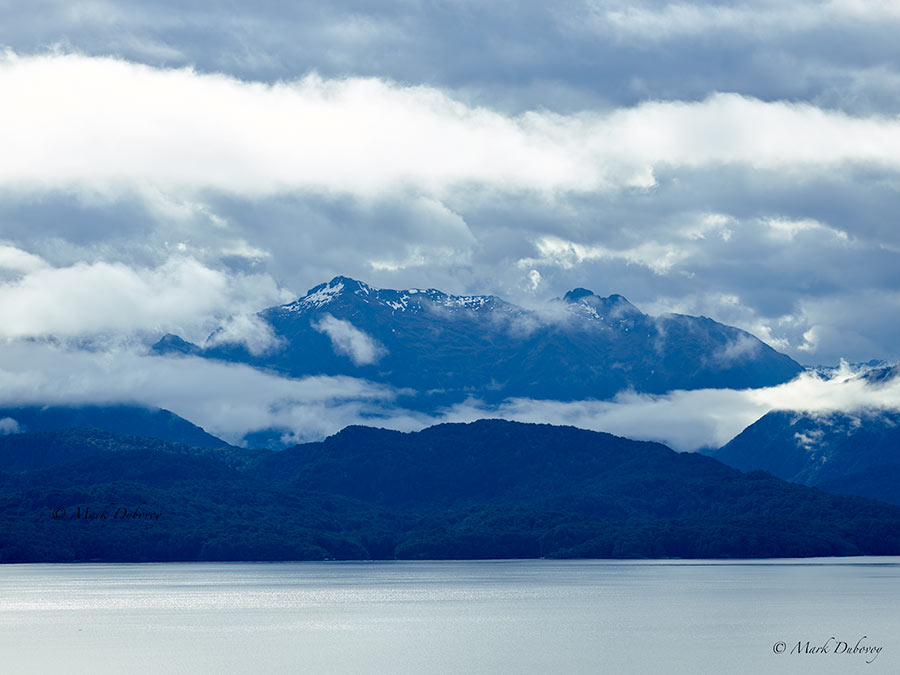
Fiordlands, New Zealand.
PhaseOne XF with 240 mm Blue Line lens and IQ 3 100 back.
I Shudder At The Thought….
I shudder at the thought of trying to do an in-depth review of such a sophisticated system in an article of reasonable length. The system has so many tools and so many features and functions that it would make the article unacceptably long just to describe the tools and functions available to the user. And this would leave me no room to describe what the system is like in real world use or the image quality.
Therefore, I have chosen to focus only on part of the main system functionality and some of the tools and features I appreciate the most. This leaves me room to also address some of the key new technologies used in the system, as well as the image quality produced by the XF System.
I would encourage those of you that are interested in finding out more about the system to go to the PhaseOne website to obtain further information and to download the user manual.
From Front To Back
Let’s look at the system from front to back. This means that we will start with the lenses, continue with the camera body, then the digital back and finally the CaptureOne software.
Lenses
There are currently 11 leaf shutter Blue Ring PhaseOne/Schneider lenses available. The focal lengths go from 35 mm to 240 mm, plus a 2X teleconverter (ideal for the 240 mm lens). In addition, there is a PhaseOne/Schneider 28 mm leaf shutter lens and 9 focal plane lenses including a tilt/shift lens. This is a total of 21 lenses plus a 2X converter. Certainly more than enough for just about any user!
The blue Ring lenses boast the highest resolution and best optical quality of the group. Having said that, I have been using PhaseOne lenses for a number of years and the more economical non-Blue Ring lenses are still excellent lenses.
For my personal system, I purchased 6 leaf shutter Blue Ring lenses in the following focal lengths:
- 35 mm
- 55 mm
- 80 mm
- 120 mm Macro
- 150 mm F/2.8
- 240 mm
I first tested the camera with the 80 mm normal lens. I was very surprised, because I was used to the quality of technical camera lenses (with usually superior image quality to SLR lenses) and the 80 mm lens seemed to be as good as a top quality technical camera lens.
This got my curiosity going, so I tested the 35 mm lens next.
Technical camera lenses usually have a significant advantage in the wide angle range because designers do not have to worry about leaving enough space for the mirror to clear behind a short focal length lens.
Let me explain this in more detail: Because of the short focal length of a wide angle lens, the focal plane is very close to the rear of the lens. Therefore, the lens needs to be very close to the sensor in order to be able to focus on it. Technical camera wide angles place the lens elements very close to the sensor. Unfortunately, this cannot be done with an SLR lens, because one needs space for the mirror to move up and down behind the lens.
In order to move the lens elements farther away from the sensor, the design of an SLR wide angle lens is more complicated, usually requires more lens elements, and some design compromises away from the optimal design have to be made. This is why in general technical camera wide angle lenses are better than their SLR counterparts.
My expectation was that the Blue Line 35 mm. lens was going to be good, but not nearly as good as a technical camera wide angle lens.
I was proven wrong when I compared the PhaseOne/Schneider Blue Line 35mm lens to the venerable 32 mm Rodagon HR lens which is a superb technical camera lens that I had used extensively. The Blue Line 35 mm lens was better! It was noticeably better near the corners. Throughout the entire image it had higher resolution, better color, better contrast, and less linear distortion. Looking at images side by side, the instant reaction by my eye/brain system was that the 35 mm Blue Line lens had higher resolution, and a more accurate and more pleasing image rendition.
The main image at the beginning of this article, “Yuba River”, was shot using the 35 mm Blue Line lens.
At this point, I decided to test the 120 mm. Macro. This lens is truly impressive. It is the best Macro lens I have ever used and a contender for the best MF lens in terms of image quality.
The 55mm and the 240 are fabulous lenses too. Of all the lenses I have tried in or near these focal lengths, they are probably the best.
More recently, I purchased the new 150mm. F/2.8. This lens is a mindblower with its gorgeous Bokeh and amazing resolution of the finest details. It also delivers beautiful color and contrast. Like a macro lens, it boasts a flat plane of focus, which is very unusual for a lens of this type and focal length. I can only say that there has never been anything quite like this lens before. This is a very special lens. If someone pushed me to pick one lens as the best MF lens ever, this one would be my pick.
I have not mentioned this yet, but the prize for the best quality of construction, tight tolerances, fit, finish and smoothness of operation of any SLR lenses goes to the Blue Line lenses. They are a cut above anything else I have used or tested to date.
After shooting thousands of images for over 10 months in all kinds of situations, including extreme weather conditions, I still marvel at the flawless performance of my lenses and the image quality they deliver.
While I have not tested all the lenses in the blue Line range, I would be very surprised if the other lenses in the line are not also world class.
In conclusion, the 6 Blue Line lenses I use, are world class and as far as I can tell, best in class.
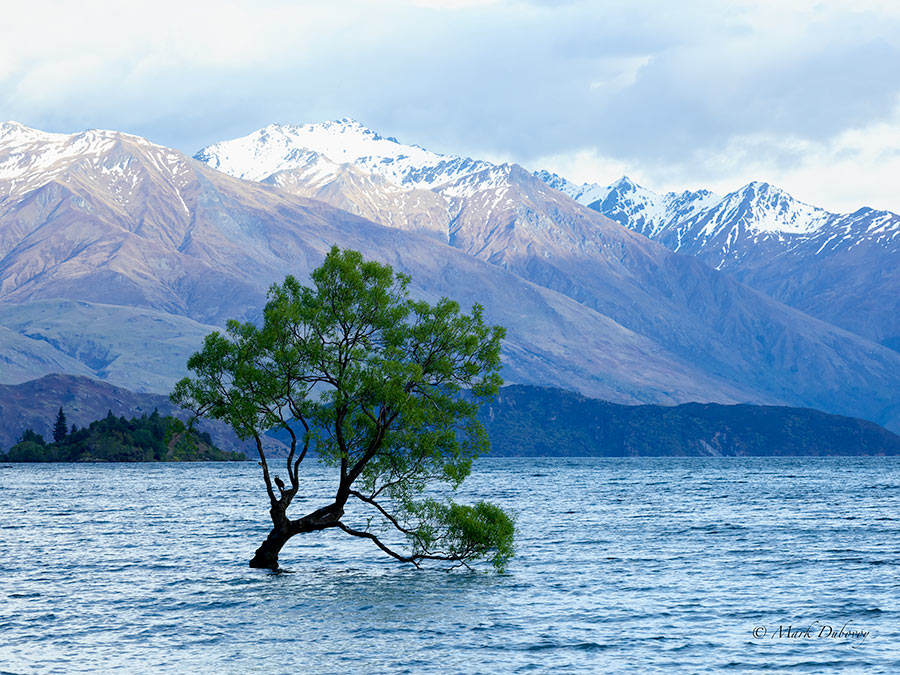
Willow In The Water. Wanaka, New Zealand.
PhaseOne XF with 150 mm F/2 Blue Line lens and IQ 3 100 back.
The XF Body
The XF camera body is a completely new design. One could say that it started with a blank sheet of paper and the only restriction was compatibility with the PhaseOne lens mount.
Completely new body designs in the Medium Format SLR world are few and far between. Medium Format SLR bodies are usually designed to last for decades. We have not seen anything this new and exciting for a long time.
It took many years to design and finally produce the XF. It is quite evident that a lot of thought went into the system and it is also quite evident that PhaseOne spared no effort and no expense in making it the highest quality body of this type.
PhaseOne spent a lot of time and effort soliciting input from photographers (including yours truly) and this really shows in the final result.
To say that the XF body is built like the proverbial tank seems like an understatement. It feels like the most solid photographic machine I have ever used, but it exudes a level of finesse and quality that does not fit the word “tank”.
The level of precision of the controls, and the precision and fit of the lens mount and the back mount feel a cut above anything I have experienced in the past. The body simply oozes quality. So does the rest of the system hardware: The lenses and the IQ 3 100 back. The fit and finish and the tight tolerances of these devices seem to be in a class by themselves.
A Fundamental Difference
In my opinion, there is a fundamental difference between the XF body and all other SLR bodies. All other SLR bodies are just that: A camera body. However, the XF is not just a camera body; it is a flexible platform that can easily be changed and enhanced.
PhaseOne clearly understands that in the world of digital photography, this body needed to become a platform that is easy to re-program and easy to enhance without having to change the hardware to do so. It is not easy to design or manufacture such a platform.
In order to achieve this goal, PhaseOne included a number of devices in the body, such as accelerometers and a second CMOS sensor that can be used for various purposes like extremely precise focusing or extremely precise exposure readings among other things. PhaseOne also had to design the electronics and the mechanics in the body so that it is extremely flexible and easily software configurable.
I consider the final result to be quite impressive. I am told that it is possible to make changes to the body from initial idea to actual implementation overnight (!).
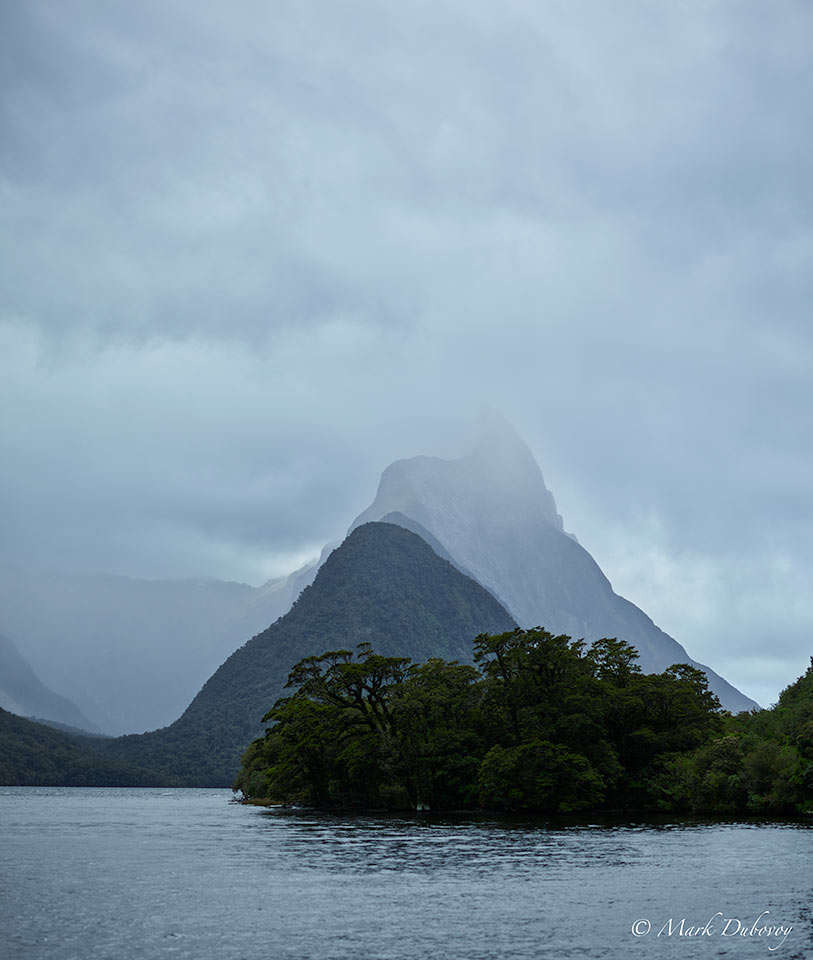
Milford Sound Fog. Milford Sound, New Zealand.
PhaseOne XF with 80 mm Blue Line lens and IQ 3 100 back.
Basic Operation
The camera body has a power button, a lens release button, 5 function buttons and 3 dials. It feels simple and just right.
The two buttons at the top of the body are elongated and silver in color. This tells you that they are different. They are used for special functions such as navigating menus (instead of using the top touch sensitive display), or to enter information such as the near and far focus points when using the focus stack function (more on all this coming up).
The other 3 buttons are round and black.
Neither the three dials nor any of the buttons in the body are labeled. This is because they can be programmed to perform different functions. It is up to the photographer to decide what is most practical and ergonomic on an individual basis.
For instance, the factory default is to have the three dials set to control lens aperture, shutter speed and ISO and the shutter release button is in the usual position for the index finger on the top right side of the body.
(Side note: One of my pet peeves for years has been that camera manufacturers do not seem to understand that ISO, aperture and shutter speed are the three parameters that determine exposure. As such, they should be directly accessible without having to push multiple buttons or go through menus. I do not recall a single other digital SLR camera body properly designed in this regard. It is great to see that PhaseOne has finally done this right!)
Now, suppose that you would like the shutter release to be the back button instead. No problem. Suppose that you want the usual shutter release button to perform a different function, such as auto focus. No problem. Suppose that you want one of the dials to control exposure compensation or something else like exposure bracketing. No problem. You can program the buttons and dials to operate in this manner.
It is worth mentioning that the options available for each button and dial are the result of extensive testing and requests by photographers. While some of them may seem strange at first, they have all received careful consideration. Here is one example: The traditional position for the shutter release button is not necessarily the optimal position. In my personal tests, using the rear button with the thumb to release the shutter produces sharper hand held images because there is less of a tendency for the camera to jerk and rotate.
The flexibility of the body goes way beyond just the dials and buttons, because the digital display on the right top side of the camera is a touch sensitive display.
Tap any function on the display panel, the function is highlighted and then the value can be changed by rotating the “main” (largest) dial.
Tap and hold any function and all the options for that function are displayed. You can then tap the option you wish to modify and you can modify it either by touch or using the dial.
If you do not see the function you are looking for on the display, for example if you wish to change the time interval in the intervalometer and it is not displayed on the screen, just swipe the display sideways (as we all do with our smart phones) and you get a new screen. Keep swiping (if needed) until the intervalometer screen appears and then tap the time interval and change it by rotating the dial.
This means that even if you forget which dial or button was programmed to control a function, you can always use the touch display and the main dial.
(Note: You can also use the touch display screen on the IQ back to control many of the functions of the XF camera body. More on this later).
While this way of operating the camera may seem only kind of nice or “cool” in the beginning, it is way beyond nice or cool. It is exceptionally good. The reason I say this is that operating the XF is totally intuitive and it completely eliminates the need for the typical (usually badly designed) highly convoluted function menus of other digital cameras.
Each and every function and each and every option is clearly and directly accessible almost instantaneously without having to remember anything.
There is no need to memorize or consult one of those dreadful multi hundred page manuals that are so pervasive for other digital SLR’s.
More On The Touch Sensitive Display
The touch sensitive display is a beautiful thing. For example, in the default mode it has an icon for the mirror. Touch the icon and the mirror immediately goes up. Simultaneously, the icon changes to show the mirror in the mirror-up position. Touch the icon again and the mirror returns to its normal position and the icon changes back to show that the mirror is in the normal position. Compare this to all the kludgy ways in which mirror up works (or doesn’t really work…) in other digital SLR’s. Once you get used to working with the XF, other SLR camera bodies seem antiquated and poorly designed.
But there is more: The touch sensitive display can also be programmed. So each photographer can choose precisely which functions are shown and in which positions. The user can also choose to have functions hidden. This is a good thing if there are functions you never use. But just in case, there is an icon available that when tapped will display all basic functions, whether hidden or not, so one more tap allows access to any function, including the hidden functions.
After the values of key parameters have been determined, all the parameter values can be temporarily locked so that there are no accidental changes by touching the panel or inadvertently pushing a button or turning a dial while shooting.
To add to all this, three individual camera setups can be named and saved not just in the camera, but also to a CF card.
This allows photographers to instantly have a body configured the way they like it: I could walk into a studio or call a fellow photographer and borrow any XF body. I can insert my CF card into the digital back and load my camera setups into the borrowed body in a matter of seconds. The body is then configured exactly the way my own body is configured to work.
I could go on further on this topic, but I believe you get the idea of how powerful and thoughtfully designed the system is.
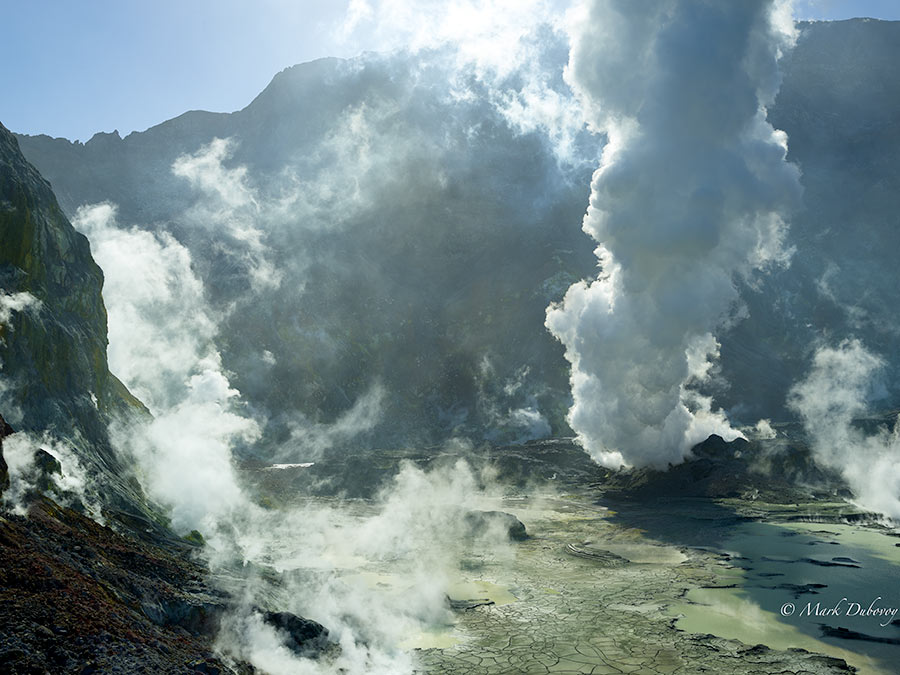
This image was captured after a helicopter landing and short hike with gas masks inside the caldera of the active volcano in White Island, New Zealand.
PhaseOne XF with 55 mm Blue Line lens and IQ 3 100 back.
Amazing Capabilities
The capabilities of the XF body are amazing. The XF sports capabilities we only dreamed about just a short time ago and there are functions and capabilities I am sure many of us never thought about previously or did not consider possible in our lifetimes.
Here are a few examples:
Do you want a seismometer in your camera body? Check. It has one. Do you want the seismometer to read the camera vibration and wait until it has subsided below a designated threshold and only then release the shutter? Check. It can do that. Do you want a seismometer graph? Check; you can see the graph.
Do you want an electronic version of a bubble level to make sure your camera is perfectly level? Of course it has that.
Do you want to do time lapse photography with a smart intervalometer that will shoot the ideal sequence? Check; the camera can do it.
Do you want to shoot a series of images focused at different distances and then process them in Helicon Focus (or other software) for more depth of field? Check. Set the XF to Focus Stack mode, choose the number of images you want to shoot and enter the nearest and farthest points you want in focus (this is done by focusing on each of the two points followed by a top silver button push). Press the rear button and the camera shoots the ideal focus stack automatically.
Do you want full lighting control of your strobes? Check. The Pro Foto Air Tool is built into the body allowing full lighting control directly from the XF body. There is also a flash analysis tool that can be used to see exactly what the timing, shape of the flash burst, intensity and duration are.
Do you want to use a waist level finder and not lose the light meter? Check. The XF can do that.
Are you a Zone System user? The XF system can show you (on the IQ 3 100 screen) the zone in which each element of the image falls for a given exposure.
And the list goes on with a myriad of capabilities including functions for hyper focal focusing, HDR stacks, controlling the camera from a distance using WiFi and a smartphone or an iPad (requires the appropriate back) and many more.
It is worth mentioning that the camera can be set to use only the focal plane shutter, only the leaf shutter (obviously requires leaf shutter lenses) or to use other modes such as leaf shutter preferred.
There is something totally new however, which I consider to be a big deal when using the XF body and the IQ 3 100 back:
The back and the body can be set to full electronic shutter. The basic concept here is that there are no moving parts during the exposure. The sensor turns on and off in such a way that the image is captured without the use of any type of mechanical shutter. No other camera system available today can do this.
(Note: The electronic shutter mode in cameras like the Nikon D 810 can start the exposure electronically, but requires a mechanical shutter to end the exposure).
I consider the PhaseOne electronic shutter to be a huge deal. Think about it: If you can mount an IQ 3 100 back in a camera body, using the electronic shutter the camera can be used with any lens as long as it can be focused. Any lens that you can mount and focus on an XF can be used and any lens that can be mounted on a view camera or technical camera with an IQ 3 100 back can be used. This opens up a whole new world where mechanical shutters are starting to become obsolete and one can interchange lens brands, or use enlarging lenses and process lenses for shooting, or try many other creative possibilities.
I also believe that this is a harbinger for the future, as I expect that at some point in the not too distant future we will have camera bodies with no mechanical components at all. The cameras will consist of a lens, a sensor and a body with electronics. We can also envision cameras where the body is little more that a carrier for a lens in the front and a digital back in the rear. These kinds of cameras will dramatically increase the reliability and accuracy of the exposure system while at the same time decreasing the weight and the cost of the camera system.
The IQ 3 100 Back
Let’s see: 100 Megapixels, CMOS sensor, close to 15 F/stops of dynamic range with full 16 bit color per channel…..
Sounds just like my impossible dream of yore, but here it is: It is real and it’s fantastic.
The IQ 3 100 is the most capable and most flexible digital back from PhaseOne. In terms of image quality, it is also the best yet from PhaseOne and it establishes a new benchmark in digital photography.
Just like the XF body, this back is strong like a tank, but it exudes quality and finesse at a level we have not seen before.
Initially the back looks completely familiar to a PhaseOne user. The form factor looks almost the same as prior backs and the usual 4 buttons and display in the back feel totally natural. Sort of like comfort food… But once one starts to dig a little deeper, the new back begins to show that it is a far more sophisticated device versus prior backs.
There are several salient features that become immediately noticeable:
- Live View- We finally have a full frame MF digital back with good Live View. The difference between the new IQ 1 and IQ 3 CMOS backs versus the CCD backs is huge in this regard. The new CMOS backs Live View is immensely useful for precise operation in the studio or in the field and for use with view cameras and technical cameras.
- Power sharing. The battery of the XF body and the battery of the IQ 3 100 back are identical. The body and the back share power, so if one battery goes down, the other one powers both devices. Power sharing also allows the photographer to replace a battery in the middle of a shoot without the system turning off.
- Electronic shutter (ES)- I have described this above, but a few things remain to be said. First, when the electronic shutter is used in a technical or a view camera, no cables are required between the back and the lens. Furthermore, the shutter can be triggered by the rear touch screen and if using a 2 or 3 second exposure delay is OK, no cable release is needed. It is worth noting that with the current ES technology the exposure takes place on a line by line basis. As such, while extremely short exposures are possible, there is a time lag between the exposure at the beginning of the first line and other areas of the image, in particular the end of the last line. This could cause an anomaly in certain kinds of images with very fast moving objects, but for the vast majority of images no anomalies are discernible. I find that for landscapes even in high winds with lots of branches and leaves moving, the captured images still look perfectly fine. I am confident that as technology continues to advance, either the time lag will become negligible, or new designs will come to market that will allow us to use ES for all subjects at very fast shutter speeds with no restrictions.
- XF Menu- One of the 4 functions linked to one of the 4 buttons in the rear of the IQ 3 100 back is labeled “XF Menu”. When this function is selected, many of the functions in the XF body can be accessed directly from the back. These include things such as shutter speed, Aperture, Mirror up, Live View, Exposure Compensation, etc. There is also a shutter release for the XF that can be operated by touch in the back screen.
- WiFi- The IQ 3 100 has built in WiFi. When activated, one can connect an iPad or an iPhone using the Capture Pilot application. This allows one to control the XF camera wirelessly. One can access and change the same functions as when using the touch screen on the back and wirelessly release the shutter. One can also evaluate a shot immediately after it is taken, by viewing it, as well as using the usual analysis tools like the histogram, focus confirmation, highlight and shadow warnings and others on the smart phone or iPad screen.
- When using a technical or a View camera with the electronic shutter, one can use an iPhone or an iPad to wirelessly release the shutter. Therefore, there is no cable release needed even for images where a shutter delay cannot be tolerated.
Image Quality
The image quality delivered by the IQ 3 100 is the best image quality I have seen from a commercially available digital device.
Compared to prior generation backs, the increase in resolution and dynamic range is immediately apparent. The reduction in noise at higher ISO’s versus CCD backs is also quite apparent.
On closer inspection, when compared to files from my prior 80 Megapixel CCD back, it appears to me that the IQ 3 100 back also has less noise at the lower ISO values. In other words, one can expect reduced noise levels at all ISO settings.
I find the 16 bit per channel color to make a significant difference versus other lower bit per channel devices. It is not just about a larger number of colors that can be reproduced, but also about color accuracy and the reproduction of subtle color nuances and color transitions. The images simply have a different and much better look to them.
Speaking of the look of the images, the color rendition of the IQ 3 100 is extremely accurate. It is the most accurate color reproduction I have experienced to date. Having said that, there are some photographers that prefer the color reproduction of CCD backs. Some even engage in passionate discussions about how CCD backs are better than CMOS backs in terms of color.
My personal opinion is that the IQ 3 100 is unmatched in color accuracy. Photographers that prefer the color rendition of a different back with a CCD sensor can use the IQ 3 100 to capture the images and create a style in CaptureOne that will deliver the color rendition they prefer with a single click. To me this makes the discussion of CCD color versus CMOS color a mute point.
(Side note: I am not a fan of the color rendition of the (smaller than full size MF) 50 Megapixel CMOS backs from PhaseOne and Hasselblad or the 50 Megapixel Pentax camera. When I tested those devices, I thought the color reproduction was not acceptable for a high end or a professional device. Images shot with those devices require unacceptable amounts of editing just to bring things to a level that is at best barely acceptable. The IQ 3 100 is a huge improvement over the older, smaller sensor 50 Megapixel devices).

Contemplation. Near Te Anau, New Zealand.
PhaseOne XF with 240 mm Blue Line lens and IQ 3 100 back.
In The Field
As mentioned above, I have been using the XF system for over 10 months, and the system is a joy to work with.
Everything seems just right. Everything I need is right where I want it whenever I need it, and the quality and precision of the system makes it a pleasure to work with.
In terms of reliability, the XF system has worked essentially flawlessly for me. Whether shooting out of a helicopter, or in the snow in freezing weather, or inside the hot caldera of a volcano, the system seems unflappable.
During the entire time I have owned the system, I have had only one small glitch where the system froze briefly and then turned itself off. I believe this might have been caused by the fact that I was pressing the shutter release very quickly, which probably caused the back to go beyond its buffering capacity. My batteries were also running low at the time, so this could have been a contributing factor. All was normal when I turned the system back on, at which point I replaced the batteries.
Other than this slight glitch (which might have been caused by user error), the system has been 100% reliable.
Is There Anything I Do Not Like?
Yes. Nothing is perfect, so there are some things I don’t like and some things I believe can be improved.
Here are three examples:
The first one is the weight of the system. In an ideal world, I wish the system was lighter, but I guess high quality glass and high quality construction at this level cannot be practically done at lower weight.
A good example of this is the prism finder which is quite heavy due to the choice of very high quality optical glass and a very sturdy metal housing. The tradeoff with this glass is weight and cost versus image quality. The tradeoff with the housing is weight and cost versus protection of the internal glass and electronics. PhaseOne chose image quality and protection as the primary considerations, so the prism finder is heavy and costly, but it delivers the highest quality viewfinder image in the business and the internal parts are extremely well protected.
The second thing I do not like is the reversible lens hoods. With the exception of the 240mm lens, all the other lenses use traditional reversible lens hoods. I have always found reversible lens hoods to be an awkward and very, very, very (3 times “very”) bad design.
These types of lens hoods are a royal pain in the butt to put on and take off and they represent just one more loose thing that can be dropped or cause something more valuable to be dropped and damaged in the field. I have missed a number of priceless images while futzing with reversible hoods, and trust me, I am not the only one.
I have heard every justification and every excuse in the book defending this type of lens hood and I do not buy any of them. They tell me that the industry is suffering from an endemic lack of thought and complete apathy regarding lens hoods. The industry simply does not care about hoods and does not want to listen to photographers who use them.
In my opinion, all lens hoods should be either sliding hoods or permanent lens hoods built into the body of the lens. The best sliding hood I have seen to date is the one in the Leica M APO Summicron 50 mm/F 2 lens, which deploys fully and retracts fully with a small rotation. It also stays automatically locked in any position until it is rotated again.
I wish everyone in the industry came to reason and stopped using reversible lens hoods!
In terms of an improvement, I wish that the prism finder had better sealing against dust and moisture in the areas where it mates with the camera body. I am hoping that PhaseOne will address this and make an improvement in the future.
CaptureOne Software
I have been using CaptureOne software for over a decade. I have used it for PhaseOne cameras as well as other brands of cameras such as Nikon, Canon, Panasonic and Sony.
Version 10 of CaptureOne, which was recently introduced, is a significant improvement over previous versions. It introduces new tools such as Halo Suppression, Diffraction Suppression, new Output Proofing tools and new Sharpening tools. It also sports improved hardware acceleration, support for very sophisticated input devices a new processing engine with much better performance and other improvements.
But to me, the crux of the matter is, as usual, image quality.
The Image Quality Champion
There is only one way to express this:
Of all the RAW processing engines on the market, CaptureOne is hands down the image quality champion. As far as I can tell, there is a very significant difference between images processed in CaptureOne and then converted from RAW to TIFF versus any other editing software/RAW converter.
I have obviously not tried every single camera on the market, but the above certainly applies to PhaseOne files as well as files from the higher end models from Canon, Nikon and Sony.
To me, this is the number one reason to use CaptureOne. The number two reason has to do with its unique tools.
Unique Tools
Besides the unmatched image quality, CaptureOne has some unique tools that cannot be found in any other editing software. These include, just to mention a few, a very unique and highly useful Color Editor, a Focus Confirmation tool, extensive Tethered Capture tools and unique Output Sharpening tools such as the capability to input the diagonal size of a desired print as well as the viewing distance and letting the software automatically apply optimum sharpening for printing to the original file.
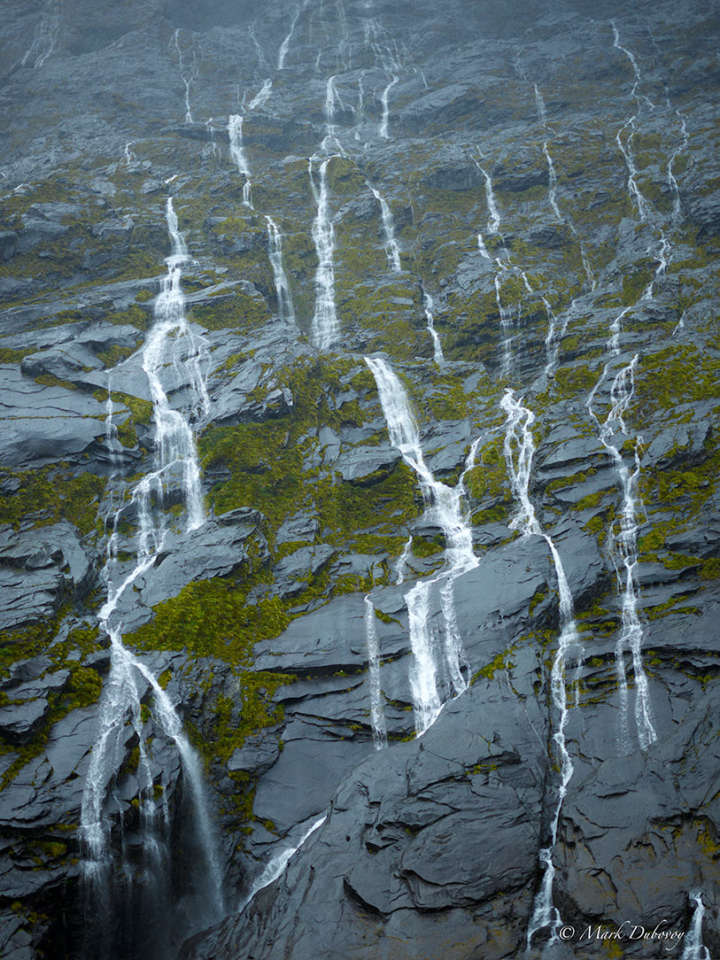
Waterfalls In The Rain.
Fiordlands Area, New Zealand.
PhaseOne XF with 80 mm Blue Line lens and IQ 3 100 back.
My Personal Workflow
Just a few years ago, I used to always import my files into CaptureOne first, perform only very basic adjustments such as white balance and then immediately convert from RAW to TIFF. This would give me the benefit of CaptureOne’s superior RAW conversion before further editing using Adobe products.
After the RAW conversion, I would import the TIFF file into Lightroom to perform a number of edits and finally export the file to Photoshop for final fine editing.
As time has gone by, I keep finding the Adobe products less and less compelling. I do not know what is happening at Adobe, but it seems to me that their products have been at a standstill, with little innovation or improvement and they are getting stale.
In the meantime, CaptureOne continues to move ahead with higher quality and better tools.
As a result, I no longer use Lightroom. It does not seem to offer anything that I cannot do at least as well, and most of the time better using CaptureOne.
Photoshop still offers some tools and functions that are either not available in CaptureOne, or are better in Photoshop.
For instance, Photoshop is better at certain types of fine selections. I also find Photoshop better for tasks like retouching dust or deleting unwanted objects in an image.
Therefore, my current workflow is to use CaptureOne for most of my editing, then convert from RAW to TIFF at which point, if needed, I perform final edits to the TIFF file with the tools that are better in Photoshop.
Conclusion
I know this has been a long article, but I believe the subject matter deserves it.
At the beginning of this article, we asked the question: Is the PhaseOne XF System the best camera system in the world?
I believe, with the caveats expressed in the first paragraph of the article, that the answer to this question is a resounding yes. There is nothing on the market and nothing that I know of on the horizon that will change this answer anytime soon.
For those interested in the highest quality tools and the highest image quality available today, there is nothing that can match the PhaseOne XF system.
Final Words
I mentioned above that for those that are interested in the system, it may make sense to try and find a workshop or an event that allows them to try the system out for themselves and make up their own minds.
We, at PhotoAesthetics, organize a select small number of workshops where it is possible to do this. We keep the number of students small so that everyone gets a lot of attention from the instructors. We believe our workshops deliver benefits that other workshops fail to deliver.
If you are interested in one of our workshops, please send an email to me or to Jim Taskett at one of the email addresses in the Contact section of this website.
I will finish this article with a short video of one of our workshops, which I think is particularly relevant to this article. I hope you will enjoy it.


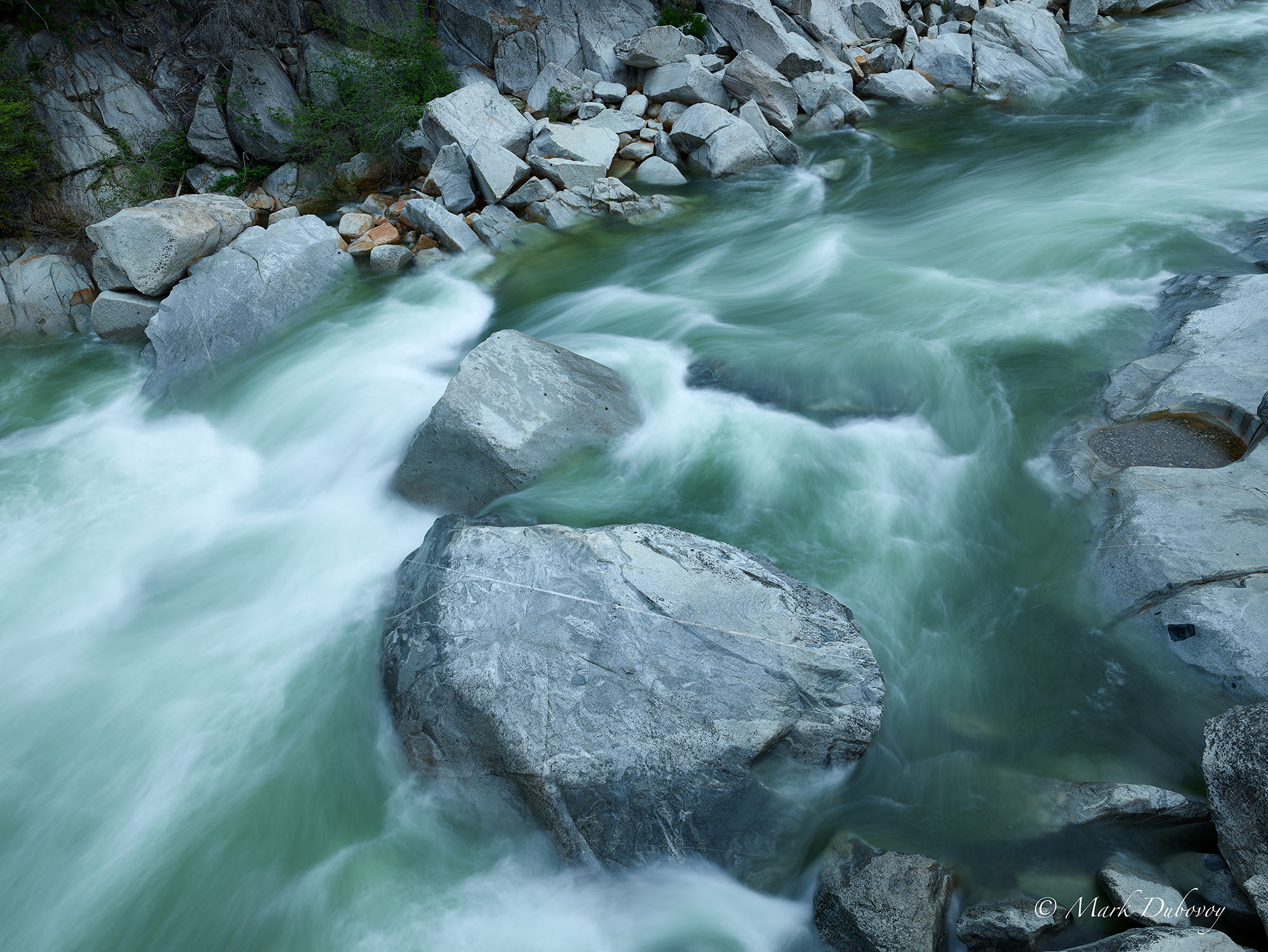



Your Thoughts